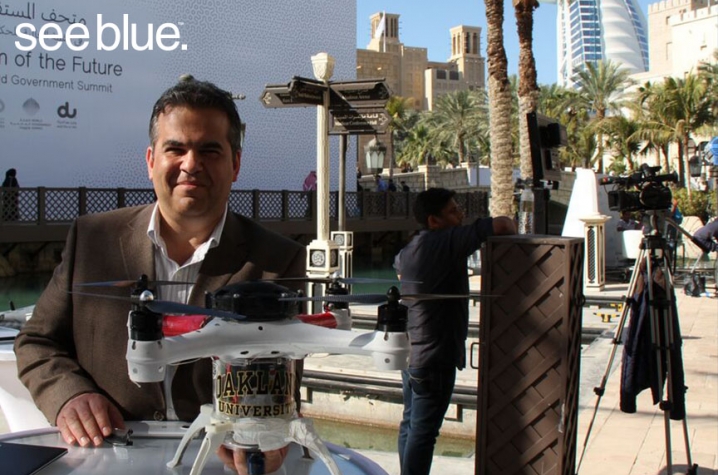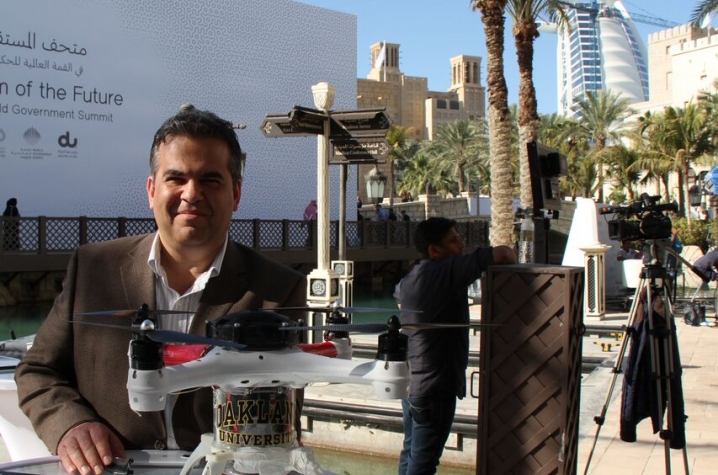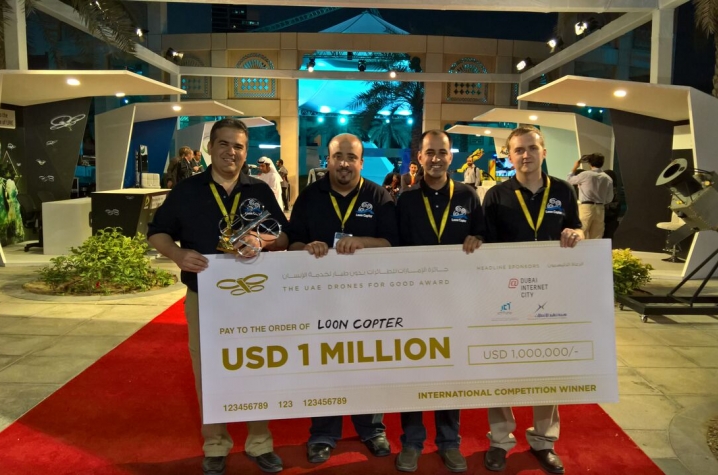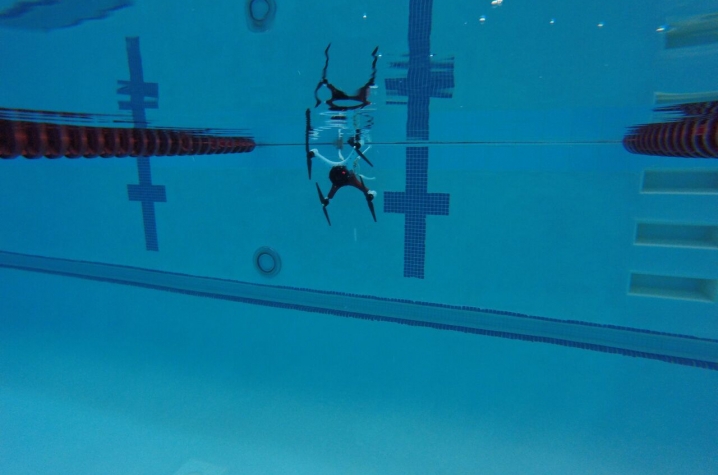A Drone for Good: UK Alum Invents Cutting-edge Drone, Wins $1 Million
LEXINGTON, Ky. (March 4, 2016) — One common topic of discussion around aerospace engineering groups is if a plane were to crash and survivors had to construct a new plane from salvaged parts, who from the group would be able to do this successfully? When the BIG BLUE (Baseline Inflatable-wing Glider, Balloon-Launched Unmanned Experiment) team of about 45 University of Kentucky students had this discussion in the early 2000s, everyone chose Osamah Rawashdeh, then an electrical engineering graduate student at UK.
So it's no surprise to his former professors and mentors at UK that the student who could design and build an aircraft from spare parts in a tough setting would go on to invent, with the help of his own students, the world's first aerial-surface-underwater reconnaissance drone.
It flies like a bird, floats like a duck and swims like a fish. The Loon Copter, named appropriately after a bird known for its powerful swimming and deep diving abilities, is taking the tech world by storm, and recently took home a $1 million first place prize from the international Drones for Good contest.
Indeed, the Loon Copter is a drone that could do a lot of good. Surpassing 1,017 other entries from 165 countries in the United Arab Emirates government's contest, Rawashdeh's drone proved it could transform search and rescue operations, environmental monitoring and underwater structure inspection, such as bridges or pipelines.
"Most other entries were application focused, but ours was truly new technology that could be applied in numerous ways, providing solutions that could save time, money and manpower," said Rawashdeh, who earned his bachelor's, master's and doctoral degrees from UK.
For example, in a search and rescue operation or investigation underwater, the Loon Copter can explore before a team of divers is called in, giving them a first look or allowing them to decide whether a dive, which can be costly and time-consuming, is needed. In another situation, the drone could fly over an oil spill to get a bird's eye view, float on the surface to collect data, and then dive far and deep to analyze the scale of the spill.
Rawashdeh grew up interested in flying but lost sight of that as he followed his electrical and computer engineering interests. Those interests led him to UK, where he became an undergraduate research assistant with James Lumpp, a professor in the College of Engineering, helping to develop a medical testing device.
"Luck would have it that Dr. Lumpp has a great enthusiasm for aviation and unmanned vehicles, which quickly rubbed off as I got involved in BIG BLUE and other related drone projects at UK over several years," Rawashdeh said.
He began working with drones right at the beginning of the modern day drone era in the early 2000s. Under the direction of Lumpp and UK College of Engineering faculty Suzanne Smith and William Smith, he was exposed to the technology that would later influence his career trajectory and lead his own team to international recognition.
"Even back then he was an exceptional student, teacher and researcher," Lumpp said. "He could build anything and then make it fly."
BIG BLUE was a series of high-altitude test experiments to demonstrate new inflatable-wing technology. The project was developed, designed, built, conducted and evaluated primarily by undergraduate students in the College of Engineering, with Smith, Lumpp and others as faculty leaders. The NASA Workforce Development Program sponsored the project and NASA reported on the project in 2004.
"I remember right before a launch that the system suddenly stopped working," Suzanne Smith said. "Everyone was running through everything in their minds while Osamah was gently probing the system."
He found a hard-to-find loose wire and repaired it. The launch went on as planned from there, the experiment was a success, and Space News reported on it as being the first to demonstrate the unique inflatable/rigidizing deployment technology in near-space (about 90,000 feet).
Rawashdeh went on to earn his master's in electrical engineering at UK. After working as a teaching assistant and helping undergraduate students in the program, he realized he wanted to keep educating young engineers. He earned his doctoral degree from UK in 2005 and started his teaching career here too, as a lecturer.
"He helped students push the boundaries of what was possible 14 years ago as a UK student and now he is continuing that with his own students at Oakland," Smith said. "What a terrific representative of UK's ideals and his experience here as a student."
While he is currently an associate professor at Oakland University, Rawashdeh's roots at UK run deep. In fact, after working with Osamah, Prof. Lumpp recruited his youngest brother Samir to do graduate work with at UK. The middle Rawashdeh brother, Nathir, also attended UK to study electrical engineering. Quite the family, Lumpp said.
"Besides the technical knowledge I gained at UK, I learned so much from the faculty advisors and mentors," Rawashdeh said. "I routinely draw on those experiences as I deal with my projects and my students today."
UK is the University for Kentucky. At UK, we are educating more students, treating more patients with complex illnesses and conducting more research and service than at any time in our 150-year history. To read more about the UK story and how you can support continued investment in your university and the Commonwealth, go to: uky.edu/uk4ky. #uky4ky #seeblue
MEDIA CONTACT: Whitney Harder, 859-323-2396, whitney.harder@uky.edu








